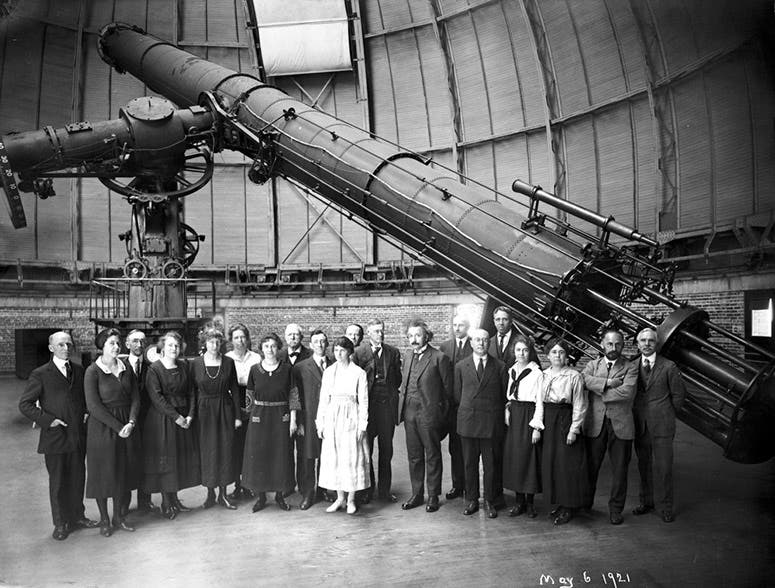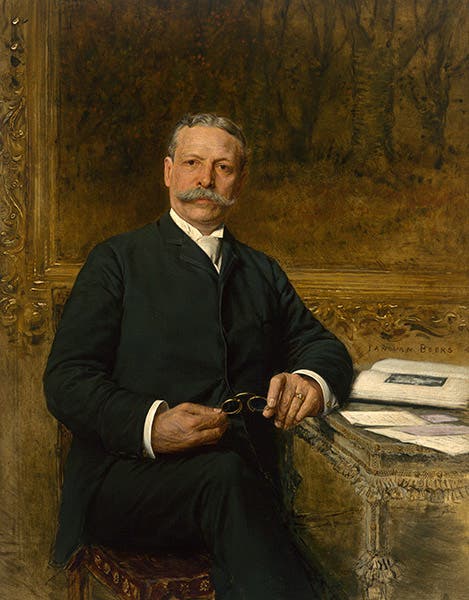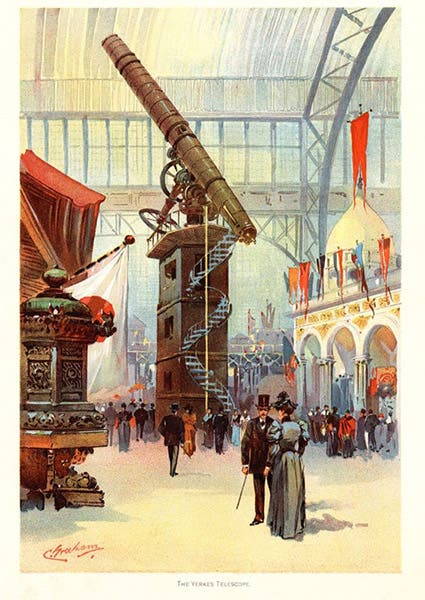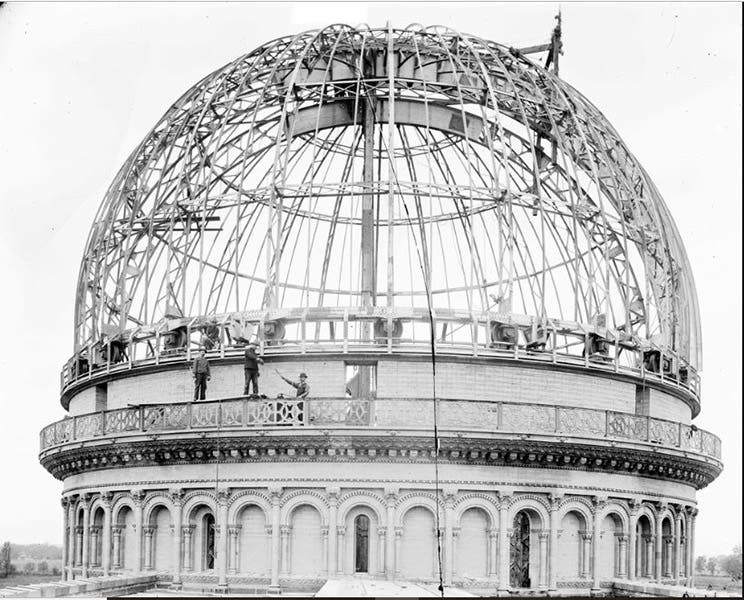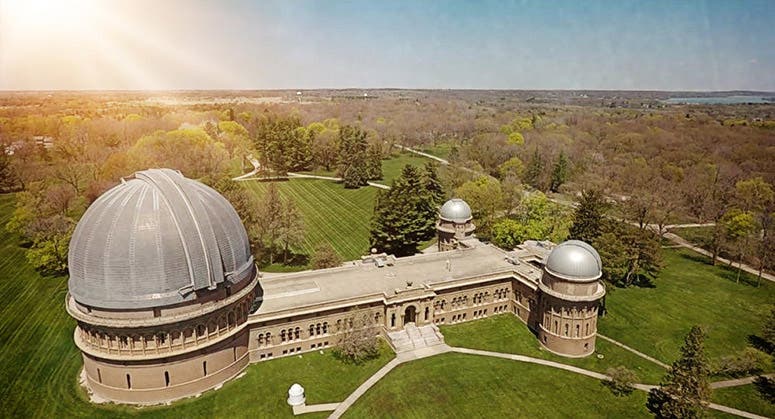Scientist of the Day - Charles Yerkes
Charles Tyson Yerkes, an American business magnate, died Dec. 29, 1905, at the age of 68. Yerkes was one of those questionable wheeler-dealers who would never have earned biographical notice in this series but for one act of generosity, and that act not even his own idea. He had spent 7 months in prison in Pennsylvania early in his career, for mis-investing public funds, before moving to Chicago and gradually cornering the streetcar business there, reputedly using blackmail and bribery to acquire various Chicago railroads. But he did acquire a fortune, and thus began his one guided foray into scientific matters.
In September 1892, a young American astronomer, George Ellery Hale (third image), learned from Alvan C. Clark, a telescope maker from Cambridge, Mass. (and son of Alvan Clark), that he possessed two large disks of optical glass, each one over 40 inches in diameter. The disks, optically perfect, had been ordered from a Parisian glass firm, intended to be ground into lenses for a telescope at the University of Southern California (USC) in Los Angeles. But the cost of the lenses had been secured by land, and when the land bubble suddenly burst, USC had to renege on its agreement. Clark was out a considerable sum, and had two massive glass blanks in his shop with no buyer in sight. Or so he told Hale.
The wheels in the brain of the 24-year-old Hale began to spin at high speed, as he immediately envisioned a world-class telescope being built in Chicago. He took the idea to the president of the University of Chicago, who was equally enthusiastic. All they had to do was find someone to pay for the telescope and an observatory to house it. Hale met Yerkes, and Hale's special talent suddenly showed itself for the first time – the ability to talk wealthy men out of considerable chunks of their fortunes in order to endow telescopes. A 40-inch refracting telescope would be the largest in the world, and no doubt the prospect of having his name attached to a world's largest man-made object of any kind was a considerable factor in persuading Yerkes to part with a substantial fraction of his wealth. He originally intended to pay only for the telescope, but Hale, over the course of time, convinced Yerkes to expand his endowment to cover not only the telescope, but a new observatory to house it. When the dust settled in 1897, Yerkes had shelled out some $300,000, a considerable sum at any time, but especially in the 1890s.
The telescope, the Yerkes refractor, was completed first, and it was displayed without its lenses at the World's Columbian Exposition in Chicago in 1893 (fourth image). Meanwhile, the Yerkes Observatory was being constructed at Williams Bay, Wisconsin, on Lake Geneva, where the seeing was considerably better than in downtown Chicago. The observatory, owned and operated by the University of Chicago, was completed in 1897, and the telescope went into operation, reigning supreme until 1917, when a 100-inch reflector was opened for business on Mount Wilson in Pasadena, California. The Yerkes refractor would continue to hold the title of the world's largest operational refractor right down to the present day, as the firm of Alvin Clark and Sons decided that larger refractors were impractical, the lenses growing too heavy, their distorting weight counter-balancing any improvement in light-gathering capacity. So Charles Yerkes had a much longer reign as patron of the world’s largest telescope than, say, James Lick, whose 36-inch refractor (also made by the Clark firm) on Mount Hamilton east of San Jose, California, completed in 1888, was the world's largest for only 9 years, until superseded by the Yerkes refractor.
The Yerkes 40-inch refractor is as handsome a piece of engineering and optics as anything on display at the Chicago world's fair, and it still is. The observatory that houses it is also quite handsome, as you can see from the modern aerial photograph (sixth image). When Albert Einstein visited Chicago in 1921, they trundled him up to Williams Bay for the obligatory (for Einstein) group photograph, on this occasion with the Yerkes refractor forming a most impressive backdrop (first image). The Yerkes Observatory and its refractor would later play a minor role in the 1996 movie Chain Reaction, starring Keanu Reeves, the footage providing a lovely sweeping view of the interior of the dome and the refractor in action, or as much action as a telescope in use ever displays.
Yerkes, as far as I can tell, did little else in his life to redeem his soul. He did live to see his namesake observatory completed and his namesake telescope put to use, and eight years beyond that. And like many rich men, he was able to commission a handsome portrait as another kind of memorial to his life (second image). But were it not for the uncanny ability of George Ellery Hale to talk wealthy men out of their money (he would go on to do this again and again), Charles Yerkes would not be remembered today as a positive force for anything. He owed Hale more than he could ever appreciate.
William B. Ashworth, Jr., Consultant for the History of Science, Linda Hall Library and Associate Professor emeritus, Department of History, University of Missouri-Kansas City. Comments or corrections are welcome; please direct to ashworthw@umkc.edu.


